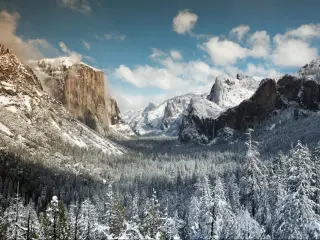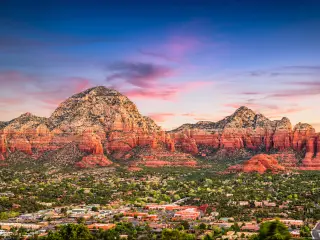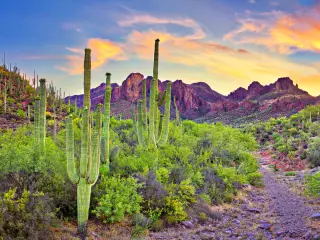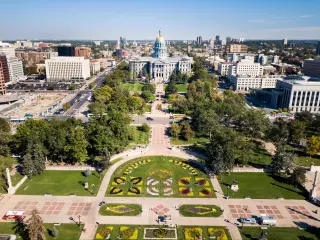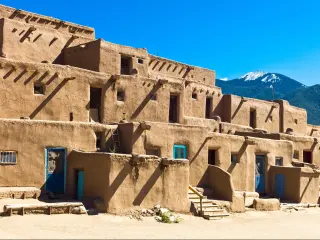Is The High Road To Taos Scary?
The High Road to Taos, connecting Santa Fe with the town of Taos, is a beautiful drive through the mountains of New Mexico, taking in many historic and cultural sites as it winds its way through the glorious scenery of the Sangre De Cristo Mountains.
Driving the 76-mile High Road to Taos takes 1 hour and 50 minutes on the mountain roads of New Mexico. The route isn't scary, and the stunning scenery, and picturesque little towns and villages, make traveling the High Road an amazing experience.
As well as the magnificent views on offer, the route is famous for its delicious local cuisine, with many regional delights to try such as Chimayo red chili and delightful handmade chocolates. Continue reading to discover the best way to make the trip and our tips to make the journey as memorable as possible.
Where is the High Road to Taos located, and why might this drive be challenging?
The High Road to Taos is an immersive experience through the Sangre De Cristo Mountains and is known for its beautiful landscapes and incredible views.
Alongside the beautiful mountain scenery, there are many charming small towns lining the route, including Chimayo, Truchas, and Las Tampas.
Each with its own unique appeal and attractions makes them excellent destinations to stop off and discover the history and culture of the area. It is also possible to catch a glimpse of the Rio Grande Gorge as you make your way past the rolling hills and forests of this stunning route.

WhilE some may consider the route to be challenging, planning ahead and familiarizing yourself with the area and the conditions, as well as driving sensibly will ensure the trip is a memorable one.
At its highest point of elevation, The High Road to Taos reaches 9,300 feet, so drivers who are not fond of mountainous roads, and don't have a head for heights may find the route particularly challenging.
The remote areas along the route are known for their rich biodiversity and are inhabited by all manner of wildlife. Elk and deer are common and can often stray onto the road, so it is important to be mindful of this when making the journey.
You can also see hawks and eagles soaring above the mountains and it is important to avoid being distracted from the road ahead.
As is common with many mountain routes, there are many twists and turns along the way, although they aren't particularly dramatic hairpins and can be easily negotiated without any concerns.
The weather always has a big part to play when traveling through mountainous terrain, and there will be a risk of snow and ice over the winter.
Ensuring you have snow chains in your car and winter tires fitted are recommended when traveling at this time of year and monitoring the local road and weather conditions is essential.
Driving the High Road to Taos
The High Road to Taos begins at the southwest foot of the Sangre De Cristo Mountains in Sante Fe. While the route skirts the foot of the range, as you get closer to Taos the road enters the mountains and increases in elevation.
The 76-mile route can be completed in 1 hour and 50 minutes but will take longer with additional time for sightseeing and exploring.

Beginning in Santa Fe, the route begins by taking the US-84W heading north towards Pojoaque before joining the NM-503 towards Chimayo. This picturesque little town is known for its traditional Spanish-style architecture and the famous El Santuario de Chimayo, a popular pilgrimage site.
Leave Chimayo heading east on the NM-76 through stunning rural landscapes towards the village of Truchas before following the road north as it twists and turns its way towards Trampas and Picuris Pueblo. Here you can explore the rich cultural heritage and history of the area in its glorious natural setting.
The route passes Picuris Peak as it descends into the Rio Grande Valley, offering stunning views over the landscape and the Rio Grande River, before arriving at Taos. Renowned for its architecture and thriving art scene, Taos is home to the UNESCO world heritage site of Taos Pueblo, and the Taos Art Colony.
Driving the Low Road to Taos
If driving at altitude isn't for you but you still want to travel to Taos, there is an alternative route available, sometimes referred to as the Low Road to Taos.
This alternative route option has its own unique attractions and gives a different perspective on the region. It covers 72 miles and can be undertaken in 1 hour and 30 minutes.
The route begins in Sante Fe where you'll head north on US-84 towards Espanola. Continue northwards with excellent views of the Rio Grande River as you run alongside it towards Embudo.
Here you can stop off and enjoy the traditional architecture and enjoy the artistic events and festivals where the locals love to celebrate their culture.
Leaving Embudo, the route continues north for a further 20 miles before arriving in Taos.
Things to know that can impact the drive on the High Road to Taos
The drive along the High Road is a wonderful experience, but the road is only a single-lane carriageway and overtaking can be dangerous. Passing places are limited along the route and the route is best enjoyed at a leisurely pace, so letting other drivers pass when possible is always recommended.
The speed limit is generally 40mph although this is reduced around some of the bends. The twists and turns along the route aren't too dramatic and are easily negotiated by keeping an eye on the signposts and driving sensibly around the curves.
Deer and Elk populate the route and are most active at dawn and dusk, so it is important if making the trip at these times to be extra vigilant for any wildlife that may have strayed into the road.
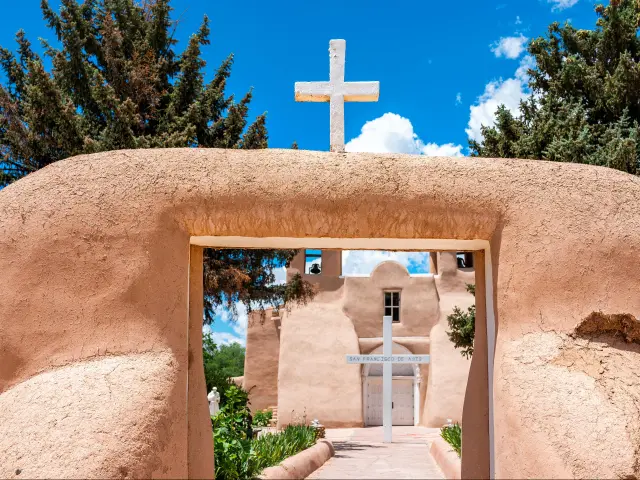
As the route is mountainous, there is no way of avoiding the elevation and it can help to understand the signs of altitude sickness if you're unaware. Headache, shortness of breath, and dizziness are all symptoms so take breaks should you feel unwell.
It is important to stay hydrated so ensure you stock up on water and snacks before setting off.
As the High Road to Taos is a scenic route, mostly used by tourists, traffic isn't particularly busy in relation to the major highways close by. There are limited options to refuel along the route so be sure to fill up at Santa Fe before heading for the hills.
The weather in the mountains can change very quickly, and it is important to plan ahead and check the local forecast. If traveling in winter, it is advisable to carry snow chains and fit winter tires, although they aren't a requirement in New Mexico, unlike other parts of the country.
The weather can cause rock slides which can result in lane or even road closures so keep up to date with local conditions: https://www.nmroads.com/mapIndex.html
Tips to drive on the High Road to Taos in the safest way
The High Road to Taos is a wonderful mountain drive and here are a few of our top tips to ensure it is as enjoyable and safe as possible.
- Driving on unfamiliar mountain roads in the dark is never easy, and making the trip during daylight hours is a much safer option. Visibility will be much improved and it's the only way to take in the magnificent views.
- Avoid traveling on weekends and holidays if possible.
- If you or a passenger is nervous driving at altitude, consider taking the Low Road to Taos instead.
- Make sure you have adequate fuel for your journey and fill up before you set off. With limited options to stop for gas en route, fill up at Sante Fe beforehand.
- Check weather and traffic advisories here.
- Do a “virtual drive” using Google Street View so that you can prepare yourself and “see” the route for yourself beforehand.
- If possible, have two designated drivers to share the load so you can stay fresh.
- Plan sufficient time for stopping off at the attractions along the way. The High Road to Taos is to be enjoyed at a leisurely pace and you should stop at viewpoints.
- Stop at the towns on the way. Chimayo, Truchas, and Las Trampas are beautiful little towns and excellent places to discover the history and culture of the area.
- Be mindful of altitude sickness and become aware of the warning signs. Stock up on water and snacks before the journey.

Alternatives to driving yourself on the High Road to Taos
Driving the High Road to Taos is a fantastic driving experience, but if you don't fancy tackling the mountain roads yourself, there are alternative options available.
Taking a guided tour of the route will allow you to sit back and relax as you get to enjoy the scenery and the most interesting stops along the way, with an informative local guide providing commentary as you go.
Another alternative way to tackle the route is by public transport. While there are limited options available along the route, there are buses from Santa Fe to some of the picturesque little towns that line the route.
Best time to drive on the High Road to Taos
The High Road to Taos offers a different experience throughout the year, and is a fantastic year-round trip. When you choose to travel will determine what you can expect along the way. Traveling midweek will always have less traffic than journeying at weekends or holiday season.
Making the trip in spring will see the mountain flowers coming into bloom and the landscape starts to come alive. The mild weather is great for exploring the towns and villages and the traffic is generally quiet.
Traveling the High Road in summer will give you the best of the weather and longer days to explore the area, enjoying the attractions and activities along the route. Whether it's hiking a local trail or enjoying a glorious summer evening picnic, summer is a great time to make the trip.
As the foliage begins to change in fall, it creates a stunning backdrop of color to the drive. The summer crowds have gone and the temperatures are still comfortable.
In any mountainous region, a road trip in winter will always have its challenges and the High Road to Taos is no different. The higher parts of the route are susceptible to snow and ice, and extra care is needed. Snowcapped mountains are a wonderful sight and it can be a wonderful winter experience.




